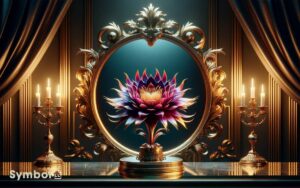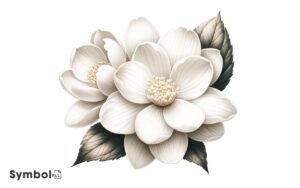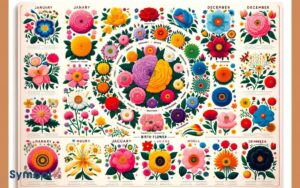Interpreting What Does a Flower Symbolize?
Flowers speak a silent, powerful language that you innately understand. Each bloom carries a weight of history, a whisper of emotion. They’re not just pretty; they’re messengers of love, grief, adoration, and support.
Imagine a rose, its petals a delicate confession of love. Lilies, with their pristine beauty, mourn a loss, while sunflowers turn faces towards warmth, symbolizing loyalty.
The language of flowers is complex, deeply rooted in cultural narratives and individual stories. You’re on the brink of discovering the profound meanings behind these natural wonders.
Each flower holds a key to a vast garden of emotions; let’s explore further to unveil their secrets.
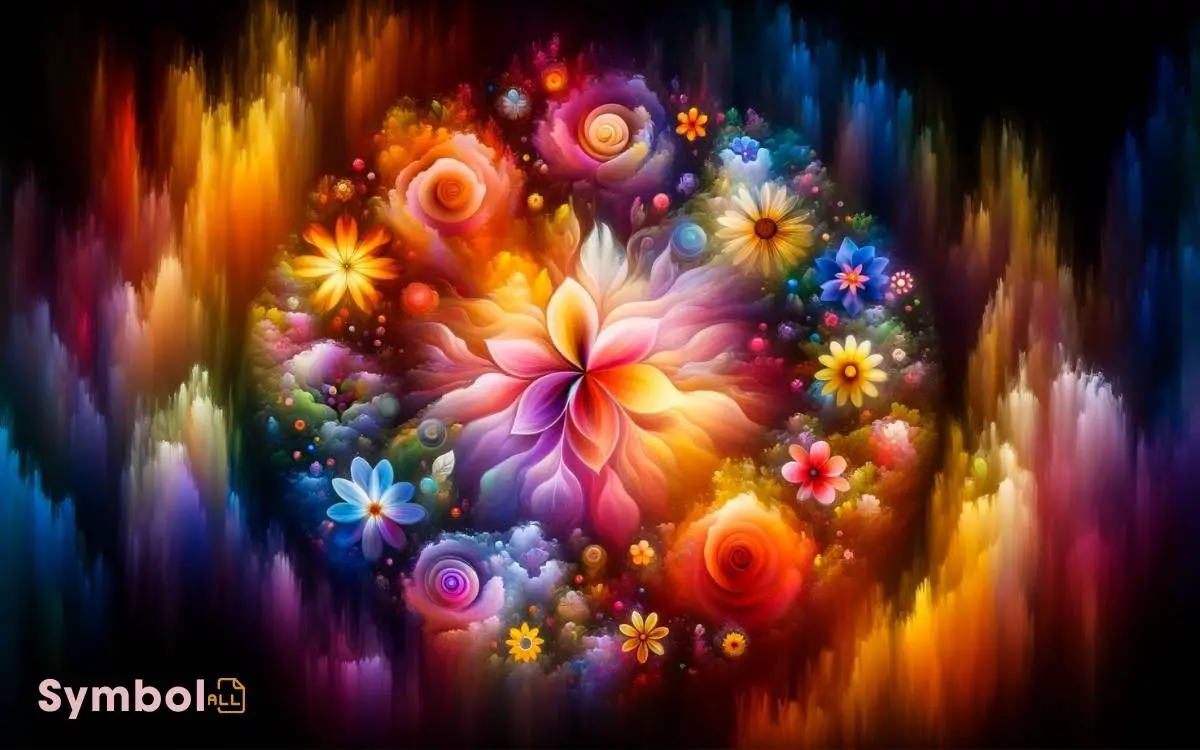
Key Takeaway
Flower Symbolism Guide: Colors and Meanings for Various Occasions
| Flower | Color | Symbolism | Common Occasions |
|---|---|---|---|
| Rose | Red | Love and romance | Valentine’s Day, anniversaries |
| Tulip | Various | Perfect love | Spring celebrations |
| Lily | White | Purity and renewal | Easter, funerals |
| Orchid | Pink | Delicacy, luxury, and strength | Mother’s Day |
| Daisy | White | Innocence and purity | New beginnings, births |
| Sunflower | Yellow | Adoration and loyalty | Summer events |
| Iris | Purple | Wisdom and compliments | Graduations, promotions |
| Carnation | Pink | Mother’s love | Mother’s Day |
| Chrysanthemum | Red | Love and deep passion | Anniversaries |
| Forget-me-not | Blue | True love memories and remembrance | Memorial services |
| Peony | Pink/White | Prosperity and bashfulness | Weddings, Chinese New Year |
| Gardenia | White | Secret love and joy | Romantic occasions |
| Lavender | Purple | Serenity, grace, and calmness | Relaxing gatherings |
| Hydrangea | Various | Heartfelt emotions or sometimes frigidity | Apologies, gratitude |
| Poppy | Red | Remembrance and consolation in times of death | Remembrance Day |
The Language of Flowers
In the enchanting world of floristry, each bloom whispers secrets, conveying messages that transcend mere words.
You’re diving into an age-old practice, the language of flowers, where every petal, color, and arrangement holds a distinct meaning.
It’s a universe where roses aren’t just red; they’re declarations of love, passion, and respect, depending on their hue.
Lilies, with their elegant curves, speak of purity and renewal, offering comfort in times of sorrow. The cheerful sunflower turns its face to the sun, symbolizing adoration and loyalty.
As you select flowers, whether for a bouquet or a single stem, you’re crafting a message that’s both personal and universal.
This language allows you to express what’s often left unsaid, connecting hearts across distances and time.
Historical Significance
Investigating the historical significance of the language of flowers reveals a tapestry of cultural narratives and emotional expressions woven through time.
You’ll find that each bloom carries a bounty of stories, transcending mere aesthetics to embody deeply rooted historical meanings.
In ancient civilizations, flowers were pivotal in rituals and offerings, symbolizing everything from divine favor to the cyclical nature of life.
Moving through the ages, they’ve served as silent messengers in the Victorian era, where societal norms restricted open communication.
Here, a carefully chosen bouquet could convey sentiments unspoken, from earnest affection to profound grief.
This rich historical backdrop highlights how flowers have always been more than nature’s adornments; they’re intricate symbols, carrying the weight of human emotions and societal values through centuries.
Roses: Love and Passion
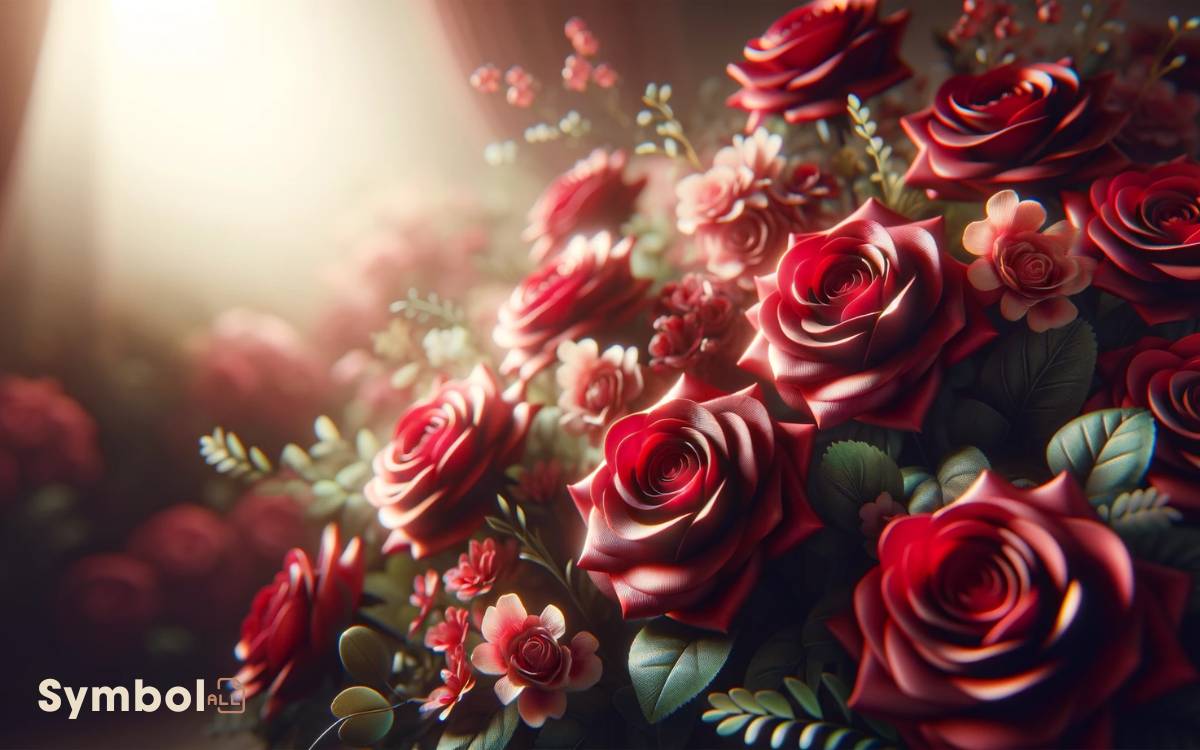
You’re about to set off on a voyage through the vibrant world of roses, where each color whispers a unique tale of love and passion.
Discover the rich tapestry of their historical significance, proof of their enduring allure through centuries.
From the meticulous care they demand to the art of their cultivation, understand how these blooms capture the essence of devotion and ardor.
Rose Colors Meanings
Often, roses aren’t just flowers but symbols of deep love and passion, with each color revealing a unique meaning that can capture the essence of your emotions perfectly.
- Red roses are the quintessential symbol of romantic love, embodying deep affection and desire.
- Pink roses convey admiration and gratitude, making them perfect for expressing your appreciation.
- White roses symbolize purity and innocence, often used in weddings to signify new beginnings.
- Yellow roses, with their bright hue, represent friendship and joy, offering a message of warmth without romantic connotations.
- Orange roses exude enthusiasm and fascination, a vibrant choice to express intense or budding feelings.
- Lavender roses, rare and enchanting, signify enchantment and love at first sight, adding a magical touch to your gesture.
Each color offers a nuanced way to convey your feelings, making roses a versatile and expressive choice for any occasion.
Historical Significance
While the colors of roses vividly express emotions in the present, their historical significance weaves a rich tapestry of love and passion that dates back centuries.
You’ll find that roses have been a universal symbol of deep affection and adoration throughout various cultures and eras.
Their enduring presence in human history highlights not just their beauty, but the depth of feelings they’re meant to convey.
- Ancient Rome: Roses adorned the lavish parties of the wealthy, symbolizing decadence and desire.
- Middle Ages: They represented confidentiality, with the term ‘sub rosa’ indicating a secret shared.
- Victorian Era: A rose given could speak volumes, with specific colors conveying coded messages of love and admiration.
Understanding the historical context enriches your appreciation of roses, transforming them from mere flowers into timeless messengers of the human heart.
Cultivation and Care
Having explored the historical depth of roses and their significance, it’s now time to focus on how to nurture these symbols of love and passion through proper cultivation and care.
Roses demand your attention and devotion. Start by choosing a spot that bathes in full sunlight, ensuring they’re planted in well-drained soil, rich in organic matter.
Regular watering keeps them thriving, but it’s essential to avoid wetting the foliage to prevent fungal diseases.
Pruning is an art; done correctly, it encourages healthy growth and blooms. It’s not just about cutting back; it’s about shaping the future of your roses.
Don’t forget to feed them with a balanced fertilizer, tailored for roses, to fuel their fervent growth.
Lilies: Purity and Grief
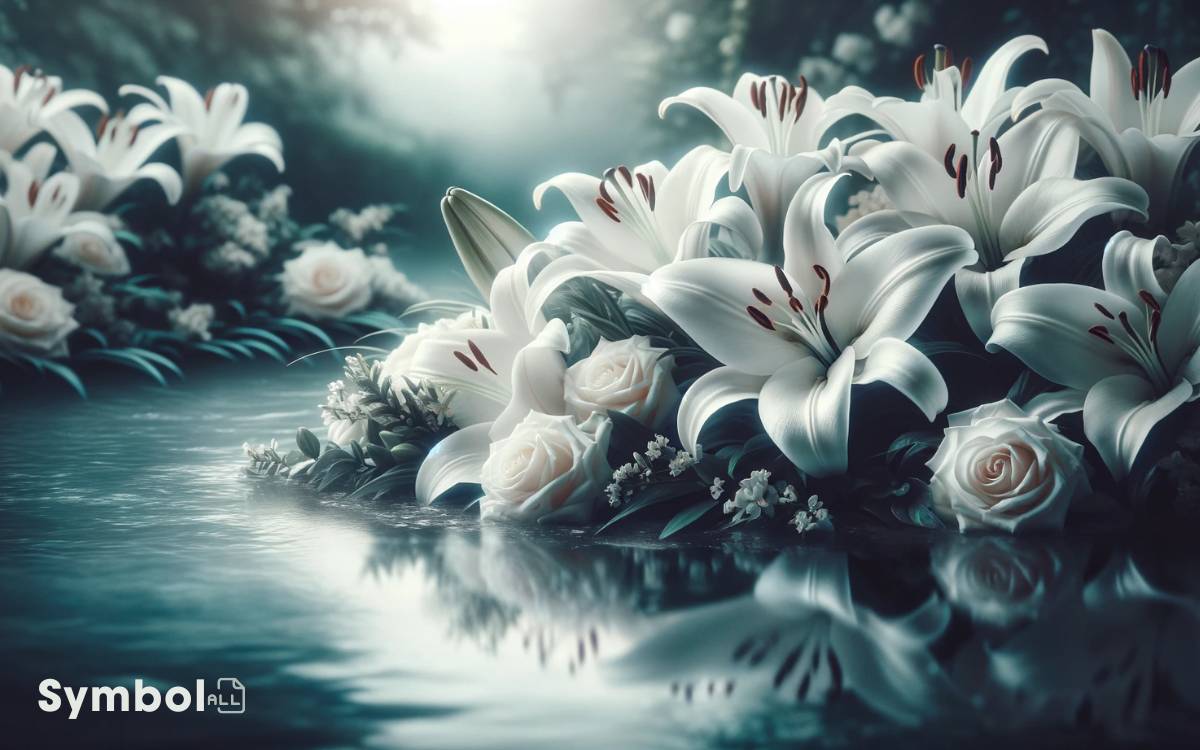
Lilies, with their pristine petals, symbolize both the purity of heart and the deep sorrow of loss, embodying a duality that resonates deeply within the human experience.
When you gaze upon a lily, you’re not just seeing a flower; you’re witnessing a profound symbol that has captivated hearts and minds for centuries.
- Purity: Lilies are often associated with the innocence and freshness of youth, making them a popular choice for celebrations of new beginnings.
- Grief: In times of mourning, lilies serve as a gentle reminder of the eternal beauty of life, even in death.
- Versatility: Their wide range of colors and varieties speaks to the complexity of human emotions, allowing them to convey messages that words alone cannot.
Sunflowers: Adoration and Loyalty
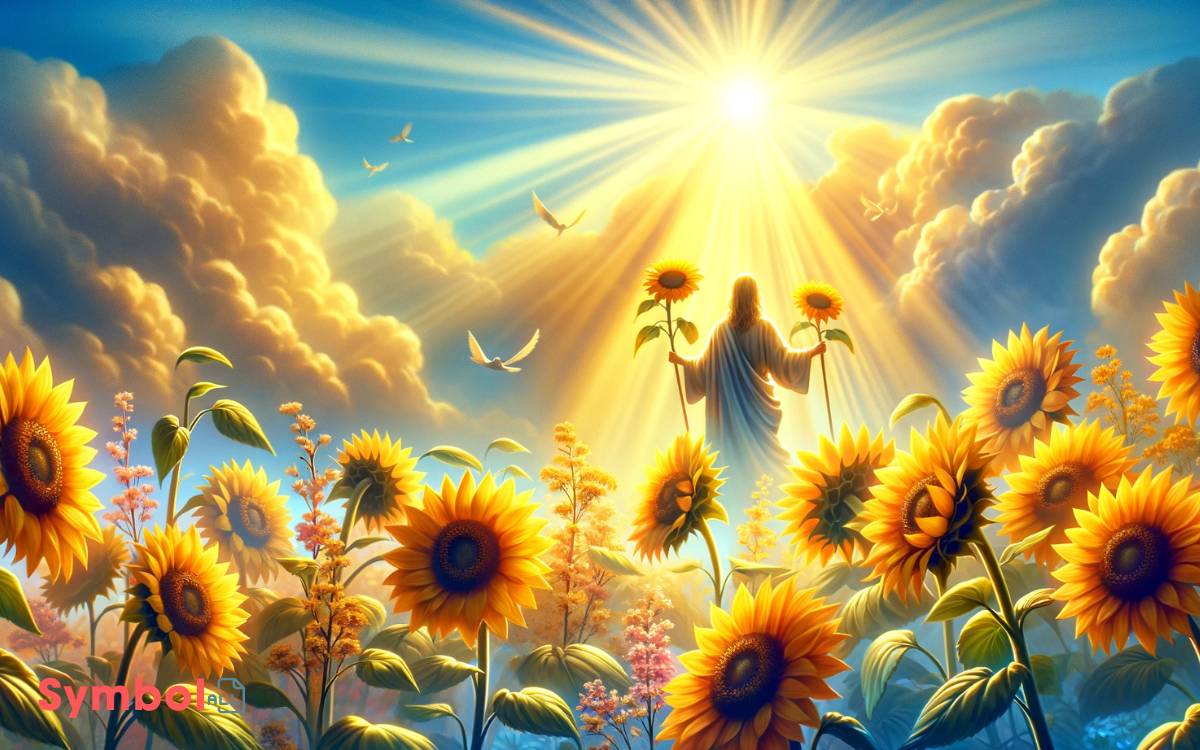
Often symbolizing unwavering adoration and loyalty, sunflowers turn their heads to follow the sun, mirroring the way we turn towards those who light up our lives.
This gesture, known as heliotropism, underscores a profound message: like the sunflower’s allegiance to the sun, our dedication to loved ones remains steadfast, regardless of life’s challenges.
Their vibrant yellow petals, bursting with color, evoke feelings of happiness and optimism, further reinforcing their association with deep, unwavering bonds.
Gifting someone a bouquet of sunflowers is more than a mere gesture; it’s a declaration of your enduring support and admiration.
Through their bold presence, sunflowers remind us to seek the light in others and in turn, radiate our warmth and fidelity.
Daisies: Innocence and New Beginnings
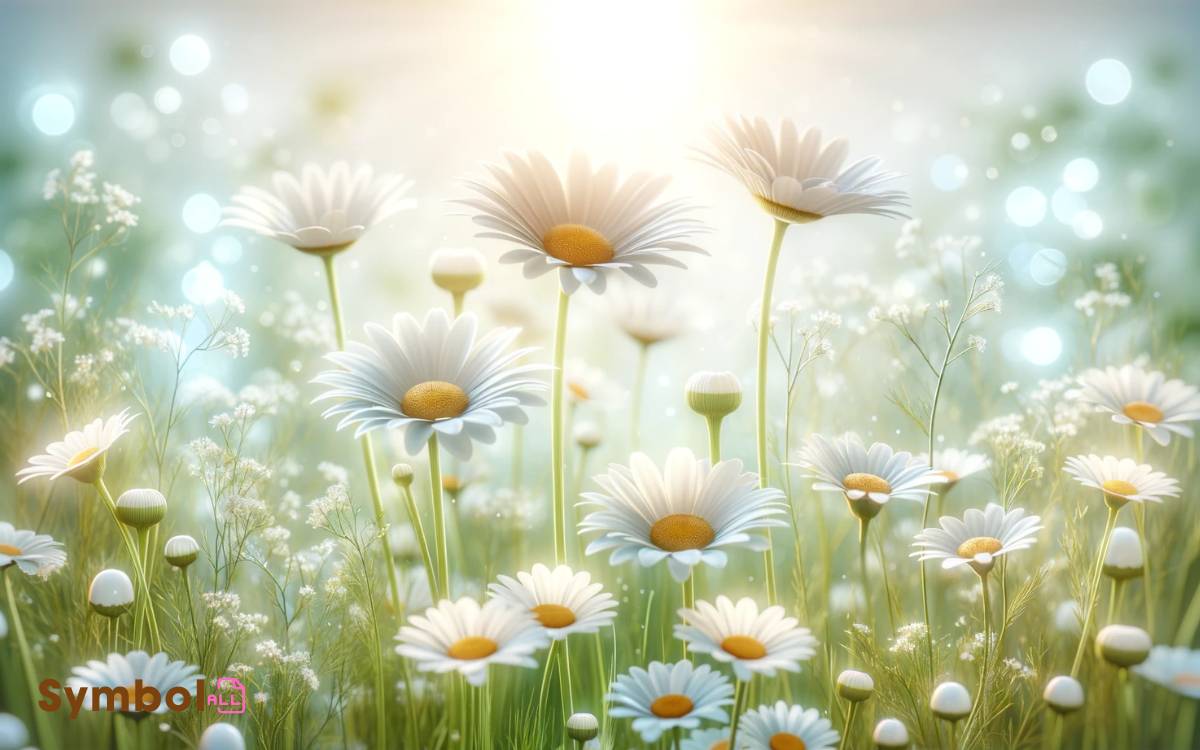
Daisies capture the essence of purity and herald the promise of new beginnings with their unassuming beauty and delicate white petals.
When you look at a daisy, you’re not just seeing a flower; you’re witnessing a symbol of hope and innocence that has resonated through cultures and ages.
Their ubiquitous presence in wild fields and gardens speaks to their adaptability and resilience, characteristics that parallel the human journey of growth and renewal.
- Purity: The white petals represent innocence, making daisies a favorite in bouquets that signify new starts.
- New Beginnings: Their cycle of blooming with the dawn symbolizes fresh starts and new opportunities.
- Resilience: Daisies thrive in wild and cultivated environments, reminding us of our ability to adapt and grow.
Understanding the daisy’s symbolism enriches your appreciation for these flowers beyond their visual appeal, adding depth to their presence in our lives.
Tulips: Perfect Love
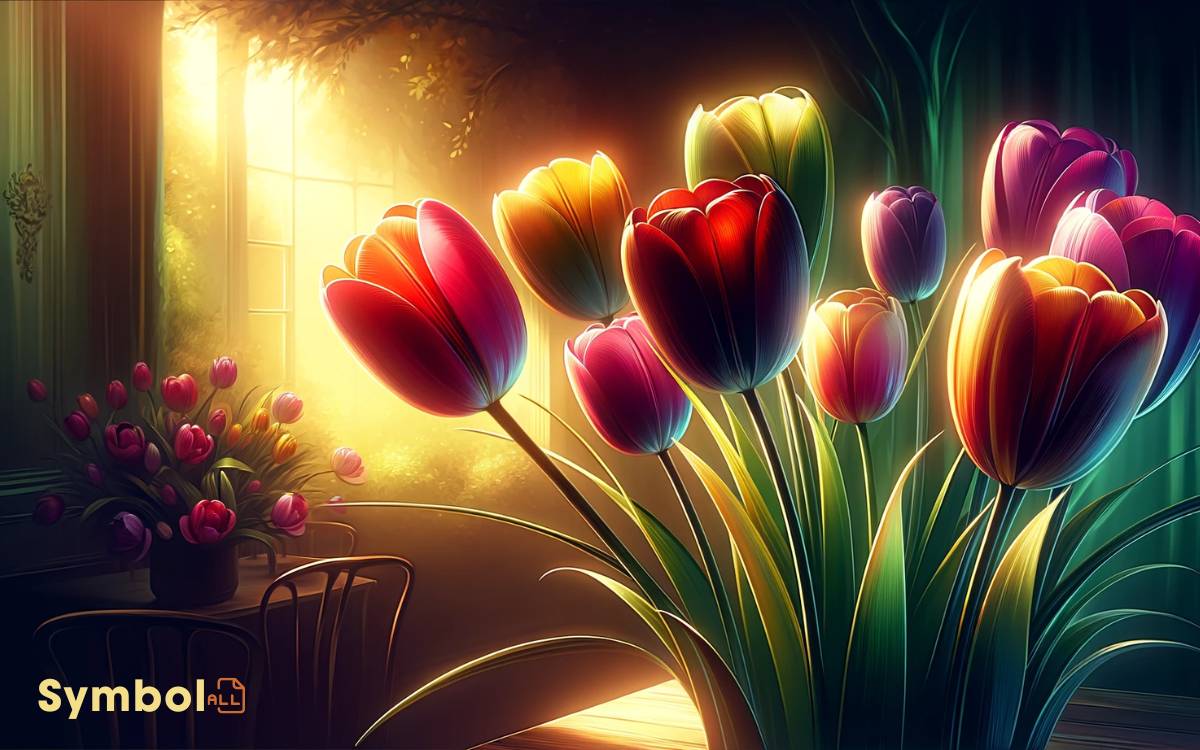
Tulips, with their vibrant hues and elegant form, symbolize perfect love, and enchanting hearts universally.
Originating from the wild terrains of Central Asia, they’ve journeyed across continents to emerge as symbols of deep affection and warmth.
Each color embodies a unique message of love: red declares true love and passion, while purple signifies loyalty.
The rare black tulip is a proof of the depths of love, representing the strength and resilience of true affection.
You’ll find that giving tulips is a profound gesture, conveying a message of perfect, undying love.
Whether it’s a bouquet of fiery reds or a mix of serene purples, tulips have the power to express your deepest emotions without uttering a single word.
Orchids: Exotic Beauty
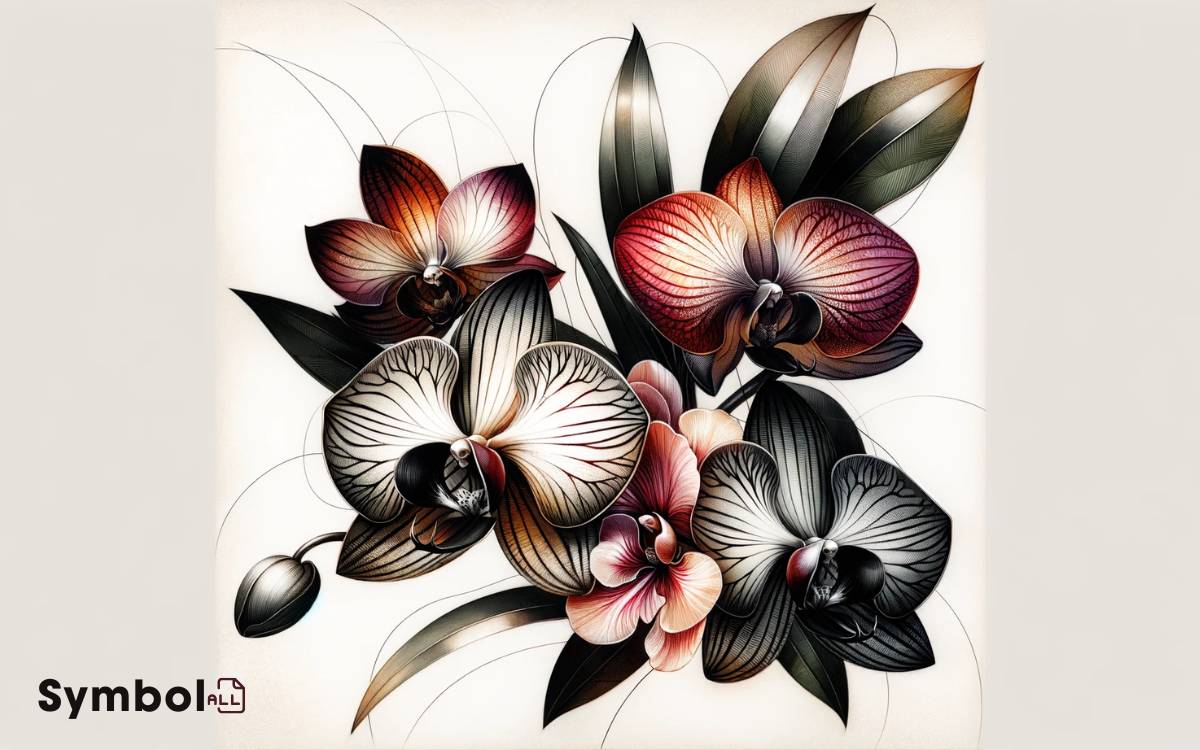
You’re about to explore the orchid, a symbol of exotic beauty and complex grace that captivates hearts worldwide.
Understanding orchid symbolism reveals layers of meaning, from love and luxury to strength and beauty, enriching your appreciation for these mesmerizing blooms.
Mastering their care guarantees these elegant plants thrive, offering a rewarding challenge for gardeners and flower enthusiasts alike.
Orchid Symbolism Explained
Orchids, with their exotic beauty, symbolize love, luxury, beauty, and strength, offering a glimpse into the depths of your emotions and intentions.
These enchanting blooms aren’t just a delight for the eyes; they carry rich symbolism and have been cherished across cultures for centuries.
Here’s what they represent:
- Love: Orchids are often gifted to express deep, passionate love, making them perfect for romantic occasions.
- Luxury: Their rare and exquisite appearance symbolizes richness and opulence, hinting at a taste for the finer things in life.
- Strength: Despite their delicate look, orchids are resilient and symbolize the power to endure and thrive in challenging conditions.
Understanding orchids’ symbolism adds layers of meaning to these already mesmerizing flowers, enriching the experience of giving and receiving them.
Caring for Orchids
Caring for these exotic beauties demands a blend of patience and precision, ensuring they bloom to their full, stunning potential.
Orchids, with their diverse and intricate forms, require a keen understanding of their unique needs.
You must mimic their natural habitat as closely as possible. This means providing ample indirect sunlight, maintaining humidity levels around 50-70%, and ensuring good air circulation.
Watering is a delicate balance; it’s crucial to allow the planting medium to dry slightly between waterings to prevent root rot. Fertilize them lightly but regularly with a specialized orchid food.
Peonies: Prosperity and Bashfulness
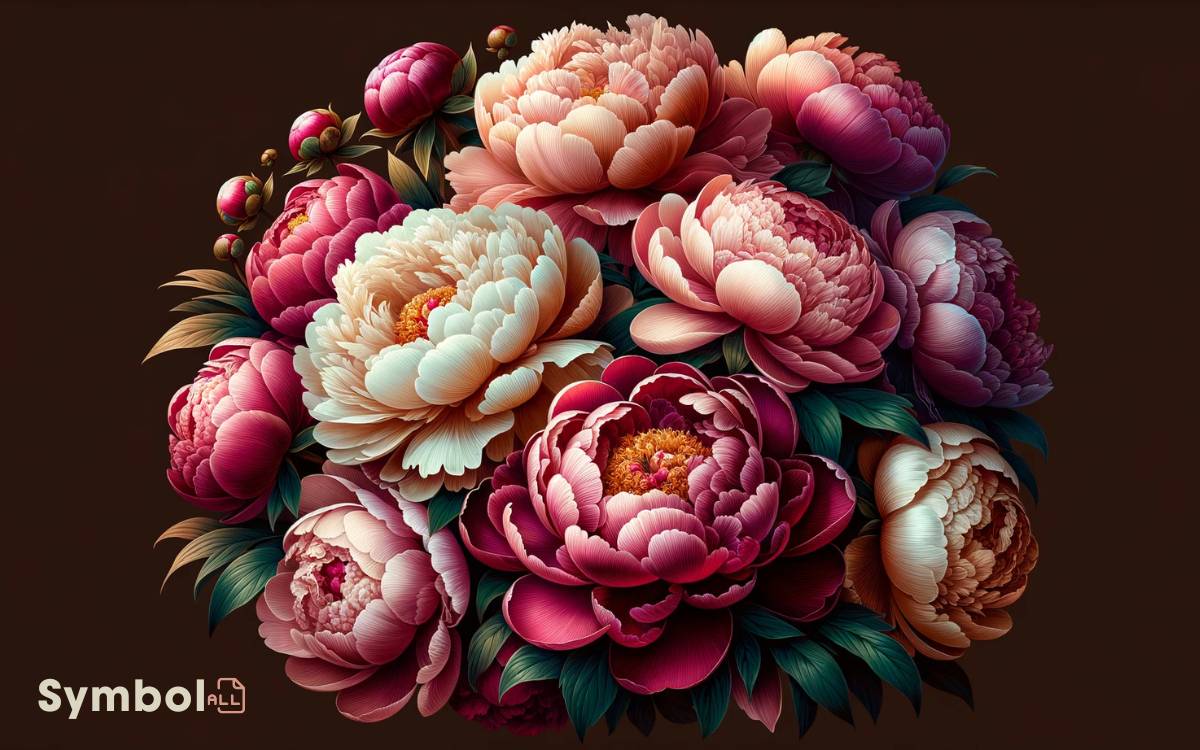
Peonies, symbolizing both prosperity and bashfulness, encapsulate the complexity of emotions in their lush, voluminous blooms.
As you gaze upon these enchanting flowers, you’re not just admiring beauty; you’re witnessing a symbol of abundant wealth and the subtle art of modesty.
These flowers carry with them centuries of cultural significance and stories, making them a fascinating subject for anyone intrigued by the language of flowers.
- Prosperity: Peonies are often associated with financial fortune and success. Their full, rounded petals represent an overflowing abundance.
- Bashfulness: In contrast, their delicate appearance and the way they seem to shyly unfurl their petals speak to a sense of modesty and humility.
- Cultural Significance: Across different cultures, peonies hold varied meanings but consistently symbolize prosperity and bashfulness, adding a layer of depth to their beauty.
Understanding peonies enriches your appreciation for these complex, symbolic flowers, blending opulence with elegance in every petal.
Lavender: Serenity and Grace
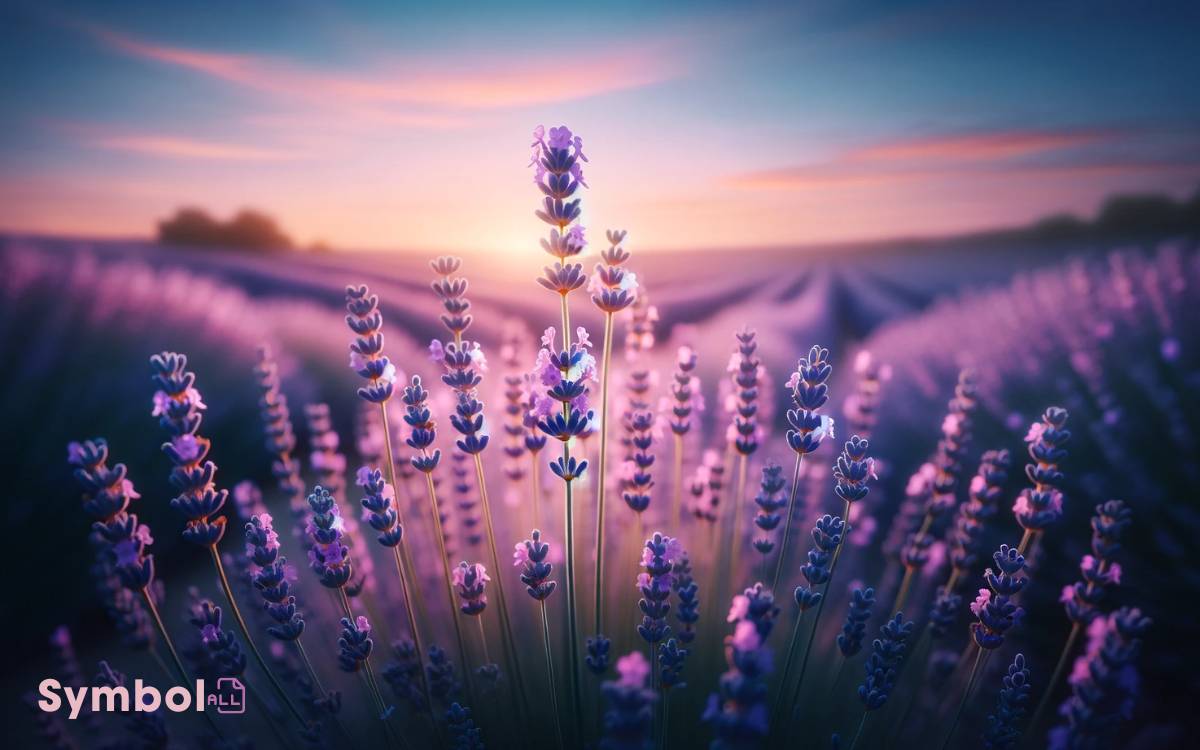
Immersing yourself in the world of lavender, you’ll quickly discover its unparalleled ability to evoke a sense of serenity and grace through its delicate fragrance and soft, purple hues.
This enchanting plant is more than just a feast for the senses; it carries deep symbolic meanings.
Traditionally, lavender represents purity, silence, and calmness, making it a perfect emblem of tranquility. Its presence in a bouquet or garden whispers of elegance and a desire for peace.
Beyond its beauty, lavender’s aroma is believed to reduce stress and anxiety, enhancing its association with serene grace.
Cultivating or gifting lavender sends a profound message of wanting to create a soothing, graceful atmosphere, showing an understanding of the flower’s power to convey feelings without words.
Chrysanthemums: Friendship and Support
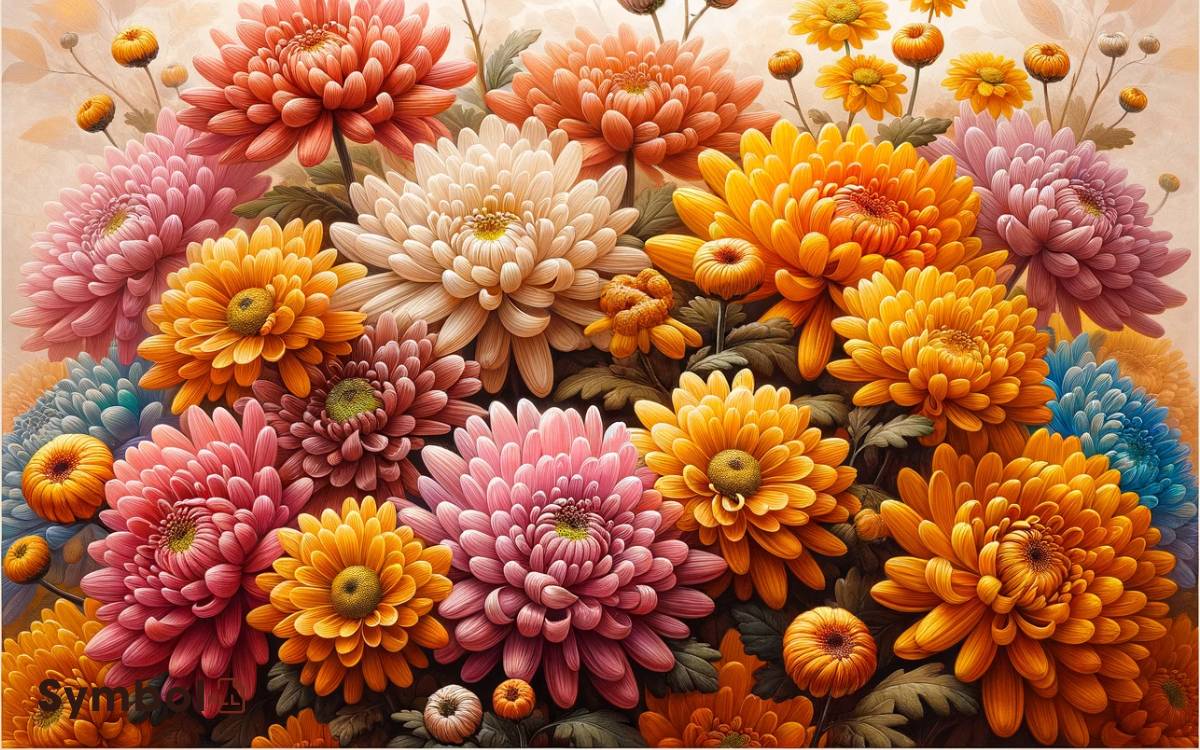
Have you ever wondered why chrysanthemums are universally recognized as the quintessential symbol of friendship and unwavering support?
These vibrant blooms hold a special place in the domain of flora, embodying the strength and longevity of cherished connections.
When you gift a chrysanthemum, you’re not just giving a flower; you’re conveying a heartfelt message of loyalty and trust.
Here’s why chrysanthemums are so significant:
- Their wide range of colors represents the spectrum of friendship.
- The robust nature of the plant symbolizes enduring support.
- Their blooming season in autumn, a time for gathering and giving thanks, aligns perfectly with themes of togetherness.
Understanding the depth behind these blooms enriches your appreciation for the subtleties of human connection, making chrysanthemums more than just a gesture of friendship; they’re a symbol of an unbreakable bond.
Cultural Interpretations
You’re about to uncover the rich tapestry of stories that ancient myths weave around the meanings of flowers, revealing how cultures across time have cherished these natural wonders.
Every petal, color, and arrangement holds a key to understanding the significance of national flowers, symbols of identity and pride deeply rooted in the heart of each country.
This journey into cultural interpretations isn’t just about flowers; it’s a window into the soul of civilizations, showcasing the profound connections humans have always shared with the floral world.
Ancient Myths Unveiled
Throughout history, flowers have woven their vibrant threads into the tapestry of myths and legends, offering profound insights into the cultural heart of societies across the globe.
These botanical marvels aren’t just a feast for the eyes; they’re steeped in ancient stories that reveal the values, fears, and hopes of civilizations long gone.
- The Greek myth of Narcissus, where a beautiful youth becomes so enamored with his reflection that he turns into the flower bearing his name, teaching lessons of pride and vanity.
- In Egyptian lore, the lotus symbolizes the sun and creation, due to its daily cycle of bloom and retreat.
- The Aztecs, with their intricate flower symbolism, believed the cempasúchil (marigold) guided the spirits of the deceased during Día de los Muertos.
These myths illuminate how flowers are more than mere decorations; they’re deeply interwoven with humanity’s most enduring tales.
National Flowers Significance
Just as every petal tells a story, the national flowers selected by countries around the world offer unique windows into their cultural souls, embodying values, history, and aspirations. You’ll find that these botanical emblems speak volumes.
Take Japan’s cherry blossom, the Sakura, symbolizing the fleeting nature of life, a poignant reminder to cherish each moment.
Or consider the resilient Shamrock of Ireland, representing the endurance and spirit of the Irish people. India’s Lotus stands for spiritual awakening, and purity amid adversity.
Each national flower isn’t just a plant; it’s a narrative, woven into the fabric of a nation’s identity, reflecting its collective heart and soul.
You’re not just observing a flower; you’re immersing yourself in a country’s legacy, one petal at a time.
Choosing the Right Flower
Selecting the perfect flower requires understanding its language and symbolism, ensuring your gesture communicates precisely what you intend.
Flowers aren’t just a feast for the eyes; their meanings run deep, steeped in tradition and cultural nuance.
To navigate this floral language, consider:
- The Occasion: Different flowers suit different occasions. Roses speak of love, while lilies often symbolize purity and renewal.
- The Recipient’s Preferences: Knowing their favorite flower or color can make your gesture even more personal and heartfelt.
- Cultural Significance: Be aware that the same flower can have different meanings across cultures. What’s considered lucky in one culture mightn’t hold the same sentiment in another.
Arming yourself with this knowledge, you’ll be able to choose a flower that resonates deeply, making your gesture one of profound understanding and connection.
The Power of Floral Gestures
Often, a well-chosen floral gesture can speak volumes, conveying emotions and sentiments that words alone can’t capture.
Imagine the depth of meaning behind a single rose handed to a loved one, symbolizing deep affection without uttering a single word.
It’s not just about the type of flower, but the color, the arrangement, and the timing, all meticulously chosen to express a specific feeling or message.
You’re not just giving flowers; you’re weaving a tapestry of emotions, memories, and hopes into a tangible form.
Whether it’s joy, love, sympathy, or apology, the language of flowers is universal, transcending barriers and touching hearts.
Embrace this powerful tool of expression; let your floral gestures articulate what’s in your heart, crafting unforgettable moments and lasting impressions.
which flower symbolizes deep thinking
The flower commonly associated with deep thinking and contemplation is the violet. Violets have long been symbolic of introspection, deep thought, and even the search for higher truths.
They have a delicate beauty and a fragrance that can evoke a sense of calm and reflection, making them fitting symbols for contemplative thought.
In literature and art, violets are often used to represent characters or themes related to introspection and deep intellectual pursuits.
Conclusion
In the garden of life, flowers are the whispers of our deepest emotions, painting each moment with their vibrant hues and delicate scents.
Choosing the right bloom is like composing a melody that sings directly to the soul, a gesture that can bridge hearts and heal wounds.
Whether it’s the fiery passion of roses or the loyal sunbeam of sunflowers, every petal holds a promise, a story untold. So, let your feelings blossom, and speak the language of flowers with eloquence and love.


